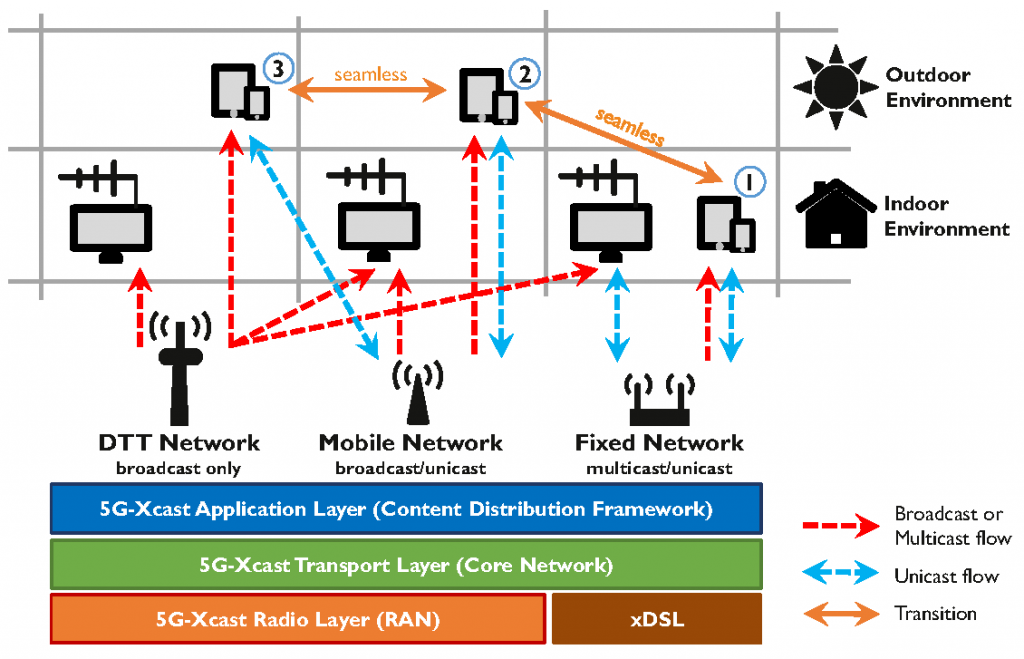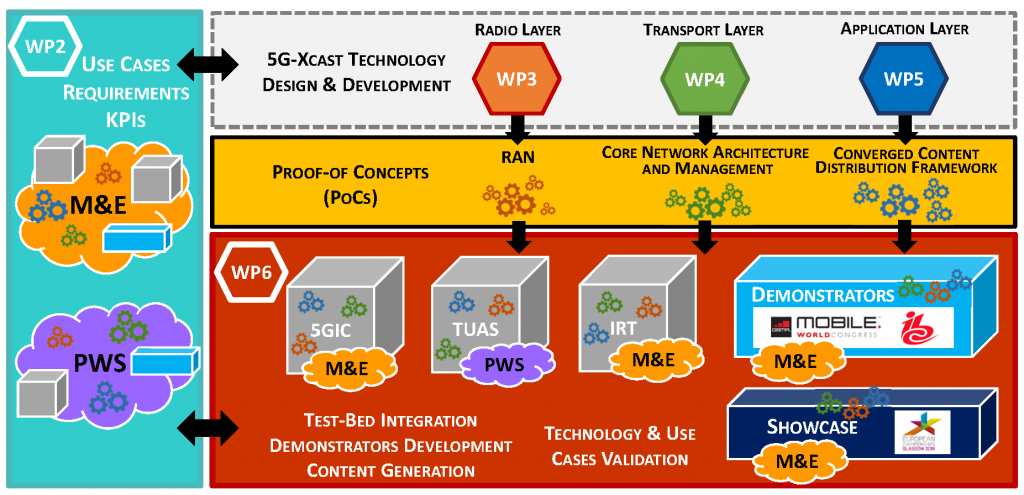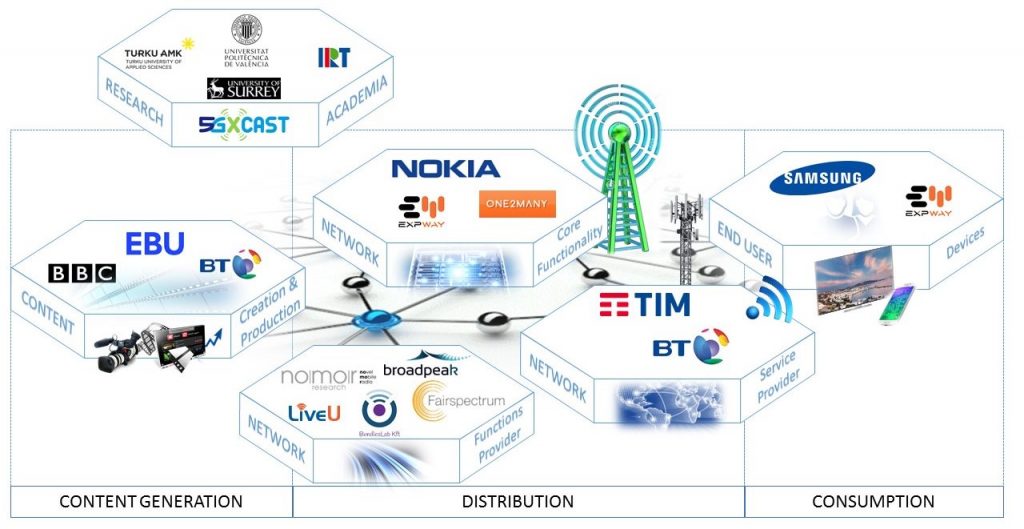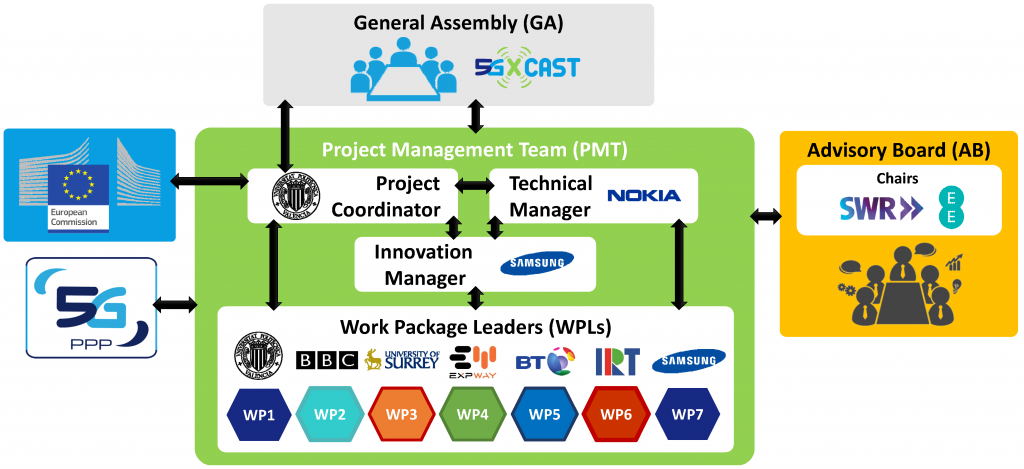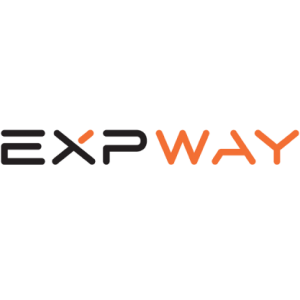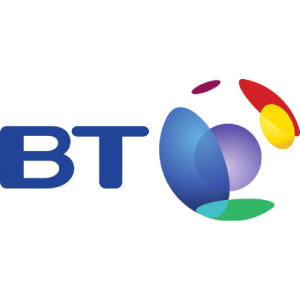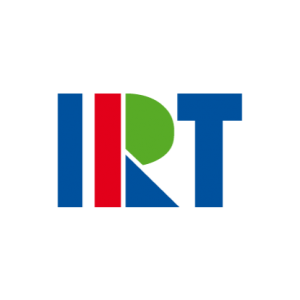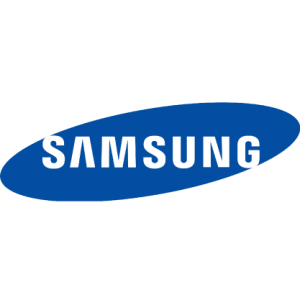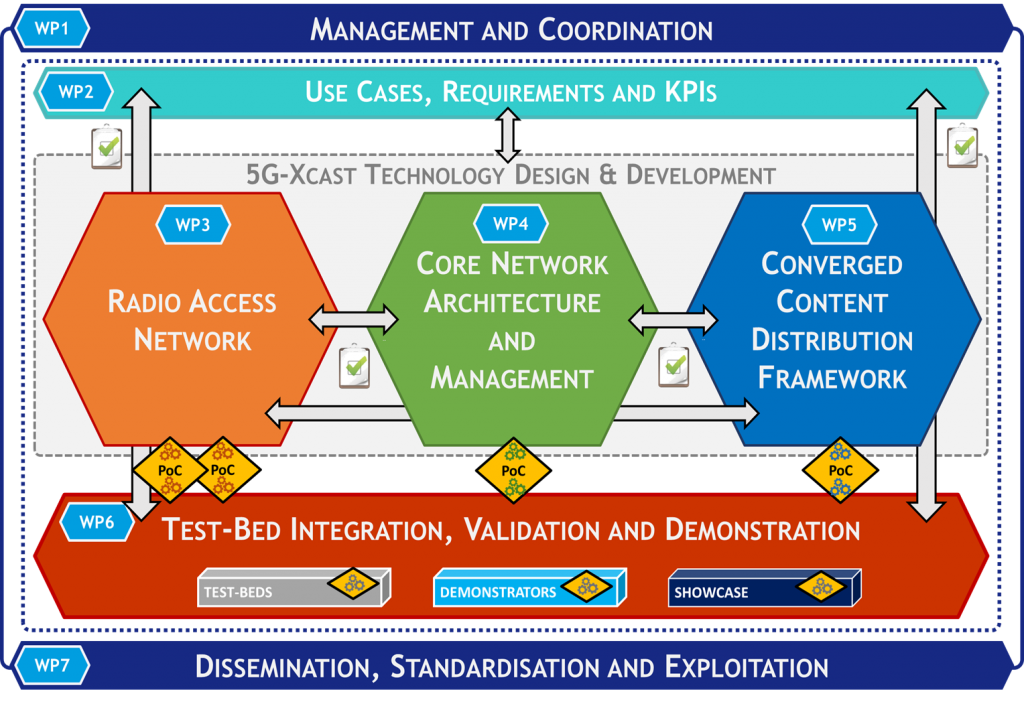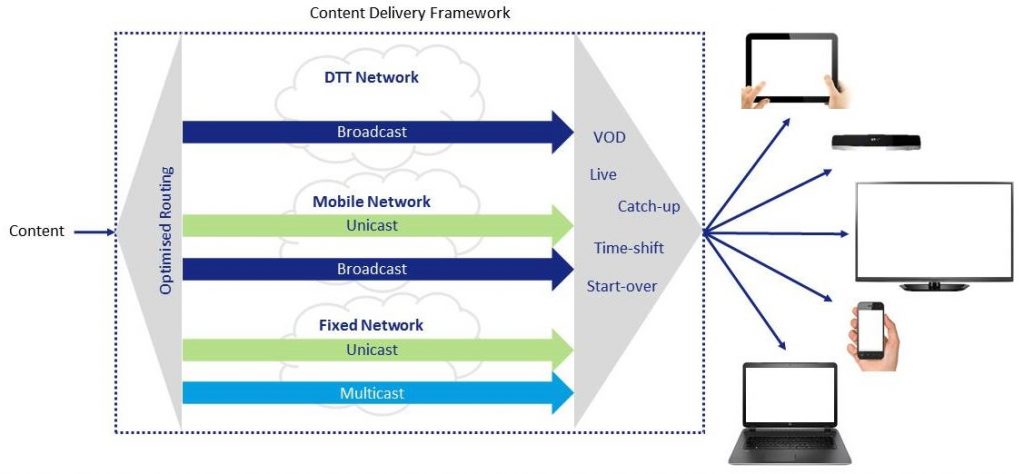

OUR PROJECT
5G-Xcast is a 5GPPP Phase II project focused on Broadcast and Multicast Communication Enablers For the Fifth Generation of Wireless Systems. The project will first analyse the requirements for future media, including 4k/8k Ultra-High-Definition Television (UHDTV), HDR (High-Dynamic Range), HFR (High Frame Rates) and wide colour space, objectbased content, Virtual/Augmented/Mixed Reality (VR/AR/MR), 360° visual media and Next Generation Audio, covering both commercial and technical aspects. Then, the project will define the top-level specifications for the transport and application layers needed to address them, along with the system architectures. Common Application Programming Interfaces (APIs) will be developed to enable a seamless access to content and services at any time, any place and from any device. 5G-Xcast will take a resolutely practical approach with comprehensive specifications, proofs of concept prototypes and demonstrations. It will closely work with relevant 5G-PPP phase-2 projects and contribute to 3GPP and other
standards developing bodies.
The 5G-Xcast system shall exploit delivery modes for unicast, multicast, broadcast as well as local caching. It will also devise strategies to facilitate the migration of media content and services from legacy systems. In developing media delivery solutions, the project will take account of the wider use ranges of 5G including services to vehicles, public safety and health, and Internet of Things (IoT) to ensure they dovetail together.
OBJECTIVES
CONCEPTS
FLEXIBILITY
Flexible technology to distribute content over fixed/mobile/broadcast networks.
USE CASES
Demonstrating Future 5G Use Cases within 5G-Xcast:
- Hybrid Broadcast Service: combination of linear and non-linear programming plus social media.
- Object-based Broadcast Service: programme stored as set of component parts (audio, video, subtitles, caption, metadata, …)
- Public Warning Messages with rich multimedia content delivery tailored to the user reception situation.
CACHING
Multicast/broadcast and caching implemented in a flexible and dynamic way to enable cost-efficient and scalable delivery of media content and services.
CONVERGENCE
5G represents an unprecedented opportunity for the convergence of mobile broadband and broadcast networks.
- Users moving between three different environments and networks.
- 5G-Xcast architecture with seamless and uninterrupted service hand-over.
METHODOLOGY
Our methodology has evolved in parallel with our working plan with the project. Addressing inter dependencies between work packages down to task level and outlining inter work package interaction at each stage.
Step I is focused on the definition of use cases to be considered in the project, and their requirements and KPIs, drawing on work already performed in 5G-PPP. This step constitutes a cornerstone of the project since these definitions will serve as a basis for technology design and development, test-beds integration, demonstration and validation of the 5G-Xcast solutions.
Step II is designated for technology innovations, and will contribute to the design and development of 5G critical technologies for the 5G-Xcast RAN, the 5G-Xcast core network and the 5G-Xcast content distribution framework taking into account the use cases, requirements and KPIs defined in Step I.
Step III consists of the development of proof-of-concept prototypes to demonstrate the main innovations achieved in the project for the radio, transport and application layers.
In Step IV, PoC prototypes will be integrated in the context of specific demonstration use cases into the three available test-beds for the project. The implementations from different partners will be brought together.
In Step V, the requirements and KPIs of the M&E and PWS use cases defined in Step I will be evaluated and validated in the three test-beds using the available PoC prototypes.
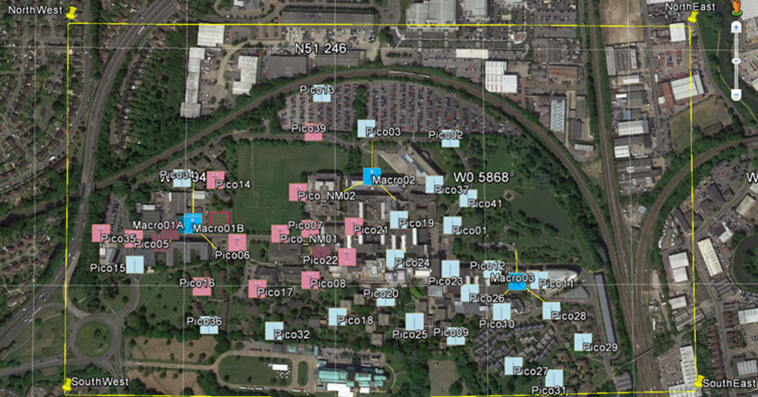
Aerial Picture of 5GIC outdoor TEST-BED.
3 Test-Beds
- 5GIC (Surrey, UK)
- IRT (Munich, Germany)
- TUAS (Turku, Finland)
Demonstrations
European Championships 2018, IBC 2018, MWC 2019
Proof-of-Concepts
For each 5G-Xcast layer: radio, transport and application.
EXPECTED IMPACT
Efficient, scalable and sustainable solution for a large-scale distribution of media services
- Fully consistent with the core 5G specifications
- Contributing to the definition of 5G and its standardisation in 3GPP.
Facilitate seamless integration of fixed/mobile/broadcast networks into a unified heterogeneous and flexible 5G infrastructure.
New sustainable business models, applications and services, and a graceful migration of M&E services from the legacy networks to 5G.
5G-Xcast will meet the future requirements of the European content creation sector and their audiences.
CONSORTIUM & STRUCTURE
Media & Entertainment Value Chain
A project of this type could not be successful without a large, experienced and balanced set of partners whose expertise covers the complete Media and Entertainment (M&E) value chain. This is the case with 5GXcast, as depicted in Figure 1a. Traditionally, the value chain of the M&E ecosystem used to be linear and straightforward. However, today this is no longer the case but rather it is a fluid and multi-directional web of complex interconnections and dependencies. Over the coming years it will continue to morph as innovation and the growth of digital content drive further changes which will require new market models and technical solutions. 5G-Xcast will open the door to a new age of immersive media delivery for Europe.
The Project Management Team
The Project Management Team (PMT) is made up of the Project Manager, the Technical Manager and the Work Package Leaders and will be responsible for the day-to-day management of the project. These responsibilities will include:
- Interacting with the General Assembly to implement the project objectives.
- Interacting with the Advisory Board, providing updates and receiving feedback.
- Managing all the technical activities and supervising the submission of financial and technical reports.
- Holding face-to-face meetings promoting discussion across work packages for maximum synergy.
- Project alignment and progress measurement against the planned milestones.
- Proactively proposing action to correct any deviations of planned work.

Project Manager (PM)
Dr. David Gómez-BarqueroProject Manager (PM)
The Project Manager (PM) is Dr. David Gómez-Barquero from Universitat Politecnica de Valencia.
The major tasks and responsibilities of the PM will be to:
– Supervise and monitor the research programme.
– Direct progress toward the objectives and milestones.
– Ensure adherence to the project timetable and optimise overall impact.
– Alert the EC’s representative as soon as possible to any issue likely to affect the attainment of deliverables and milestones as well as propose appropriate contingencies to address such issues.
As well as represent the 5GXcast consortium in negotiations and discussions with the EC; distribute funds among partners; oversee, collect and prepare the technical and financial reports according to agreed timescales; submit these to the EC; convene, organise and chair project meetings.

Technical Manager (TM)
Dr. Athul PrasadTechnical Manager (TM)
The Technical Manager (TM) is Dr. Athul Prasad from Nokia, who will supervise the technical execution of the project for its duration, ensuring alignment with the work plan. The TM will report to the PM and implement the technical decisions of the Project Management Team. The TM will be also responsible for the implementation of risk management policies and supervising the drafting of technical reports and their timely submission, as well as ensuring the quality of all deliverables.

Innovation Manager (IM)
Dr. Belkacem MouhoucheInnovation Manager (IM)
The Innovation Manager (IM) is Dr. Belkacem Mouhouche from Samsung who is leading the WP6 (dissemination and standardisation). Using his long experience in generating IPRs and participating in standardisation processes, the IM will work with the consortium members and the PMT to maximize the innovation impact of the project. The IM will report to PMT the progress made in IPR generation and innovation in products and services undertaken by partners.
IMPLEMENTATION
Work Plan
The 5G-Xcast project is divided into Work Packages (WP), each covering a complimentary body of work within the project. Each WP has an assigned WP Leader, essential to coordinating not only the scope of the work package, but as an interface between WPs via their respective WP leaders. Although each WP has its own respective scope, there is heavy dependencies between the WPs. The 5G-Xcast work plan identifies and plans for some initial dependencies but special attention will be paid, through the entirety of the project duration, on coordination between the technical WPs. The work in each WP is further subdivided into tasks, where each task had a defined task leader. The 5G-Xcast Work Pages are defined below.
WP 1: Management and Coordination
Leader: Universitat Politècnica de València (UPV)
Description
WP1 aims at guaranteeing an efficient and effective overall management of the financial, administrative, technological and operation aspects of the project; covering all the management activities, setting up the management structures and providing a link to the EC officers, as well as 5G-PPP. This WP is responsible
for clear definition of the activities, with a coherent assignment of the responsibilities and work distribution with emphasis given to project milestones and deliverables. Throughout the life of the project, this WP will be monitoring the progress of the technical outcomes of the project, detecting and managing potential risks. The production of interim and final progress reports will ensure the consistency of the actions to be undertaken with the specific and overall project objectives. This WP will start 2 months before the official project kick-off to prepare in advance all the necessary management tasks such that the technical WPs can start working from day 1. A single task T0.1 will be carried out during the whole project. UPV, as project manager, will be in charge of management and coordination activities. On the other hand, the technical execution will be coordinated by Nokia, as technical manager.
Objectives
- To ensure coordination of the workflow and the administrative/financial management for project operations (general project management).
- To guarantee scientific/technical leadership of the project (technical project leadership).
- To ensure that the project’s results are properly managed from the viewpoint of IPRs, ethics of project conduct and exploitation of results.
- To intervene through risk management procedures in the event of deviations from planned work.
- To ensure that the project’s results are properly communicated to related projects in 5G-PPP, to the scientific community and to relevant business actors.
- To provide strategic guidance to the project also in terms of liaison with relevant stakeholders or complementary initiatives and manage relations (including complete and timely reporting) with the European Commission (EC).
WP 2: Use Cases, Requirements and KPIs
Leader: BBC
Description
In WP2, all uses cases relevant for the project will be identified, including use cases relating to M&E, PWS, Automotive and IoT. M&E and PWS use cases will be prioritised since they match the core competences in the consortium. The use cases will be developed to both exercise the limits of and demonstrate the benefits of the 5G-Xcast approach. They will include both existing applications that could be enabled and enhanced through this solution as well as novel approaches such as object-based broadcasting. 5G-Xcast will draw on the knowledge and experience of partners participating in the project, but also on existing work such as 5G-PPP phase-1 projects, 5G-PPP work on verticals, 3GPP, EBU and the ETSI ISG MBC group. For the aforementioned use cases, relevant technical and regulatory requirements and KPIs will be defined that will provide a key input to other WPs and serve as a basis for demonstration and evaluation of the project results. In addition, the project will address those automotive and IoT use cases that can be enabled by one-to-many delivery approaches (broadcast and multicast) and whose requirements are largely aligned with the requirements of the above mentioned M&E and PWS use cases. In defining the relevant automotive and IoT use cases, 5G-Xcast will seek cooperation with other 5G-PPP projects and guidance from the AB.
WP2 is led by the BBC and is divided into four tasks. T1.1 will define the use cases to consider, and it will be led by the EBU because they have done a considerable amount of work on media related use cases for LTE (both unicast and eMBMS) as well as in the context of 3GPP and 5G-PPP. T1.2 is devoted to the definition of requirements and KPIs. BBC will lead this task as well. In T1.3, WP1 will validate and verify the performance of technological solutions considered. IRT will lead this task due to their wide knowledge on the M&E vertical sector. T1.4 will explore the longer-term use cases for a possible future work and it will be led by TIM in consideration of its long track record in relevant innovation fields and SDOs activities, as enabler of a suitable strategic view.
Objectives
- Definition of use cases
– Define all use cases relevant to 5G-Xcast
– Examine use cases in terms of whether they should be supported by multicast or broadcast
– Prioritize use cases for investigation within the project
– Identify the issues in addressing these use cases with existing networks and approaches
– Illustrate how these will be enabled by the developments within 5G-Xcast
– Identify how different convergence scenarios could target the use cases
– Draw on work already carried out in, for example, the 5G-PPP Verticals Whitepapers - Define explicit technical and regulatory requirements and KPIs for the use cases
– Define the requirements and KPIs for each use case
– Examine the requirements in terms of, amongst other things, scale of coverage (local or nationwide), multicast/broadcast support, latency, quality & integrity, application (streaming or downloading), bandwidth, etc.
– Capture the requirements such that they can be the target for subsequent developments within the other work packages and to benchmark both the existing state of the art (i.e. ‘4G’ eMBMS) and the new techniques developed within 5G-Xcast
– Define how different convergence scenarios could help to deliver the use cases more effectively. - Ensure use cases are realisable through coordination with other WPs
– Review to what extent use cases and their respective requirements and KPIs are being realised within the project and potentially revise them in light of knowledge gained in the project - Identify future work and longer term use cases, i.e. beyond those addressed in the project
– Examine to what extent the initial use cases have been met by developments within the project
– Identify other use cases that could be enabled through the technology researched within 5G-Xcast
– Assess the scope for future work and potential new business models
WP 3: 5G-Xcast Radio Access Network
Leader: University of Surrey
Description
WP3 is focused on the radio access network for future broadcast/ multicast 5G transmissions. As such, it will address the studies related with the air interface, RAT protocols and RAN architecture design, and it will devise the 5G evolution of eMBMS. The physical layer techniques to be investigated include modulation,
coding and interleaving, waveform and MIMO precoding/beamforming, etc. It is worth mentioning that this poses new challenges and requires innovative solutions in comparison with unicast transmissions. Examples of specific broadcast constraints are the implementation of SFNs to transmit the same content at the same frequency and time resources from different sites (in both cellular low-power low-tower and broadcast high-power high-tower wireless infrastructure deployments), the placement of local content in SFNs, or partial (and sometimes even the complete absence of) channel state information at the transmitter. The performance of the proposed solutions will be evaluated in terms of throughput, spectral efficiency, reliability, coverage, mobility robustness, latency and required signal-to-noise ratio. The WP will mainly contribute to the progress beyond the state-of-the-art in the areas of transmitter radio interface and receiver signal processing algorithms. The aspect of receiver complexity and its trade-off against system performance penalty will be also taken into account.
WP3 will be led by the 5GIC of UNIS that will be leveraging on its recognized experience on 5G radio aspects. WP2 will be divided into five tasks. T2.1 will be led by the BBC, which has carried out pioneering studies on eMBMS, including the UK’s first trial and is contributing to the ongoing standardisation work within 3GPP Rel’14 that will be completed before the project starts. It will characterise this state of the art in 4G to act as a benchmark at the start of the project. T2.2 will produce the air interface specification, and it will be led by UPV that will be using its experience in different terrestrial broadcast air interface standardisation activities such as DVB-T2 and ATSC 3.0. T2.3 will address the design of the 5G-Xcast RAN architecture, and it will be led by Nokia that has a long experience of innovations in the design, development and standardisation of 2G-5G mobile network architectures. Nomor, who have over the years gathered extensive experience in radio resource management, will lead T2.4, focused on RAT Protocols and RRM. T2.5 will be devoted to develop the 5G-Xcast RAN PoC prototypes. This task will be led by UNIS due to their wide experience developing new radio prototypes.
Objectives
- Design a highly efficient 5G-Xcast RAN baseline solution that fulfils the requirements and use cases developed in WP1 in terms of selected KPIs such as data rate, latency, reliability, and power consumption, across different verticals (M&E, automotive, IoT and PWS).
- Provide a comprehensive and holistic 5G Broadcast PTM RAN solution, including the radio interface, RAT protocols and RAN architecture, and assuming CUPS architecture, for consideration in different standardisation groups including 3GPP RAN, leveraging on the results of 5G-PPP phase-1 and on-going
work in 3GPP related to point-to-point unicast transmissions. - Prototype the promising 5G-Xcast radio access techniques for demonstration and proof-of-concept.
WP 4: 5G-Xcast Core Network Architecture and Management
Leader: Expway (EXP)
Description
WP4 will define the network architecture, efficiently combining fixed, mobile and broadcast networks, to realise the 5G converged core network. It will make use of unicast, multicast and broadcast data transport to optimise network utilisation as a function of the demand along with flexible session control and resource management. It will be led by Expway, which is a current leader on LTE Broadcast core network equipment. WP3 will be divided into four tasks. T4.1 will be led by Expway and it will define the mobile core network.T4.2 will define the fixed and broadcast core network and integrate them with the mobile core network
defined in T4.1 to realise the converged 5G core network. This task will leverage previous work of 5G-PPP phase-1 projects on core network (e.g. NORMA, SUPERFLUIDITY), and it will be led by BT, as an expert on the fixed and mobile networks, and their integration. T4.3, led by LiveU as an expert on the efficient use of available network resources, will address session control and resource management to make the best use of network resources. Using simultaneous multiple network connection types to improve the QoE will also be addressed. T4.4, led by O2M as a leader of cell broadcast solution and an expert on core network functionalities, will build PoC prototypes of the 5G converged core network with dynamic selection of both network types and data transport method. These PoC prototypes will be integrated with the work from WP3 and WP5 for test-bed evaluation and validation in WP6. This task will be led by O2M because it has a vast experience in in trials and in deployment projects with very experienced engineers and project managers.
Objectives
- Define the 5G converged core network architecture which combines fixed, mobile and broadcast networks and uses a mixed of unicast, multicast, broadcast transport and caching capabilities to achieve optimal network efficiency.
- Propose flexible session control and resource management to meet the needs of new and diverse 5G use cases.
- Develop PoC prototypes of the 5G-XCast converged core network’s key components.
Leader: BT
Description
In this WP, 5G-Xcast will set out a vision of a flexible, self-organising content delivery network which can combine unicast, multicast, broadcast and caching to deliver content cost-effectively at scale. It will outline the broad operation of such as system in a network-agnostic manner and will identify and propose the core
functional elements to help realise our vision. The project will further demonstrate how some elements of convergence can be achieved with minimal network support by using intelligence at the transport protocol and application layers. WP5 will be led by BT. BT is one of the world’s leading communications services
companies, and its experience will help to manage WP5. WP5 will be divided into four tasks. T5.1 sets out the project’s vision, and will explain what is considered to be a ‘good’ framework suitable for content delivery in a manner that is consistent with the approach used on the Internet. T5.2, led by BT, will review a range of developing technologies and propose a framework that uses some or all of these to achieve the vision set out in T5.1. T5.3 validates the vision and the framework by describing how the project will apply these to some typical challenges. LiveU will lead T5.3, bringing their experience of combining content over different and independent mobile networks, as well as providing one of the base technologies to use. Finally, T5.4 will build the ideas designed in WP5 into different PoC prototypes. Expway will lead this task. Whilst most partners will be involved in most tasks to some degree, they will have particular roles to play. Those partners which are, or have close links to, broadcasters and other types of content service provider will have a particular focus on representing the users of our proposed Content Delivery Framework to ensure that the framework provides the right APIs, both from the content sources, and to the applications on the end devices. These organisations will include BBC, BT, EBU, and IRT. Various partners will have direct technology knowledge to contribute to the framework. BBC, BT, Broadpeak and Expway will contribute knowledge variously on fixed and mobile networks, particularly in the areas of dynamic or autonomous MooD. Various partners will bring special knowledge of terrestrial TV broadcast requirements, particularly for public service broadcasters. These organisations will include BBC, EBU and IRT. LiveU brings experience of TV contribution over mobile networks, together with BundlesLab, as well as providing one of the base technologies of this WP in the form of multilink bonding. UNIS will ensure that the framework influences WP2 and is reflected in the capabilities of the 5G broadcast RAN, particularly in terms of possible support required for autonomous MooD, as well as the support of hybrid and multilink networks by MSMB RAN architecture.
Objectives
- Produce a network-agnostic content distribution framework which can combine unicast, multicast, broadcast and caching to optimise network resources dynamically, whilst;
– Keeping the interface between the content service provider and the network operator as simple as
possible assuming that any requirement that can be met by content service provider alone will be provided
using the content distribution framework, rather than using the network features.
– Treating multicast, broadcast and caching as built-in internal network optimisations, not as a service to be offered to content service provider. - Develop PoC prototypes of the 5G-XCast application layer intelligence key components.
Leader: Institut für Rundfunktechnik (IRT)
Description
WP6 will integrate the PoC prototypes developed in WP3/4/5 into the three test-beds, and support the effort for testing and demonstration under the use cases of M&E and PWS defined in WP1. This WP will plan and integrate the PoC prototypes in the three existing tests-beds and will plan and develop the demonstrators that will showcase 5G-Xcast technologies. The existing test-beds will be further developed in order to allocate a selection of 5G-Xcast functionalities and the considered M&E and PWS use cases. Moreover, demonstrators will be developed to enable the demonstration of novel M&E and PWS use cases and services. This WP will perform laboratory, field tests, and measurements to complement the theoretical analyses and simulations. In addition, the different trials will be used for validating the research results obtained and its compliance with targeted KPIs of the M&E and PWS use cases. Trials will be performed to validate the proposed technology solutions in relevant environments. WP6 will also develop demonstrators to promote the main innovations of the project, including the showcase for the European Championships 2018. Five different tasks are included in WP6. The development of demonstrators and test-beds integration will be defined in T6.1. TUAS will lead this task, coordinator of the FUHF project and owner of the test-bed that will be used to test PWS use case. T6.2 will ensure the quality, appropriateness and attractiveness of the content to be used for trials in test-beds, showcase and demonstrators. EBU will lead T6.2 because of it experience with content generation and coordination, and because is a principle organiser of the European Championships 2018. This showcase, along with the demonstrators, will be handled in T6.3, which is led by BBC, due to its experience in M&E demonstrations. In parallel, T6.4 will integrate the PoC prototypes into the test-beds. This task will be led by UNIS, in charge of one of the three test-beds. Demonstrators and test-beds will be validated in T6.5. This task will be led by IRT, which will be in charge of the continuous evaluation of the use cases in WP2.
Objectives
- Plan test-bed trials of the M&E and PWS use cases, in coordination with WP3, WP4 and WP5.
- Develop the three existing test-bed described in Section 1.3 to support the demonstration of use cases with PoC prototypes developed in WP3, WP4, and WP5.
- Integrate the 5G-Xcast proof-of-concept prototypes developed in WP3 (RAN), WP4 (Core Network) and WP5 (Converged Content Distribution) into the three test-beds of the project.
- Development of content to demonstrate M&E and PWS use cases.
- Perform test-bed trials of the M&E and PWS use cases.
- Provide feedback to WP2 (for use cases requirements and KPIs validation), WP3, WP4 and WP5 (for system optimisation) based on the tests performed.
- Create attractive demonstrators/show cases as basis for dissemination activities in WP7, including the mandatory demonstrator for MWC’2019.
WP 7: Dissemination, Standardisation and Exploitation
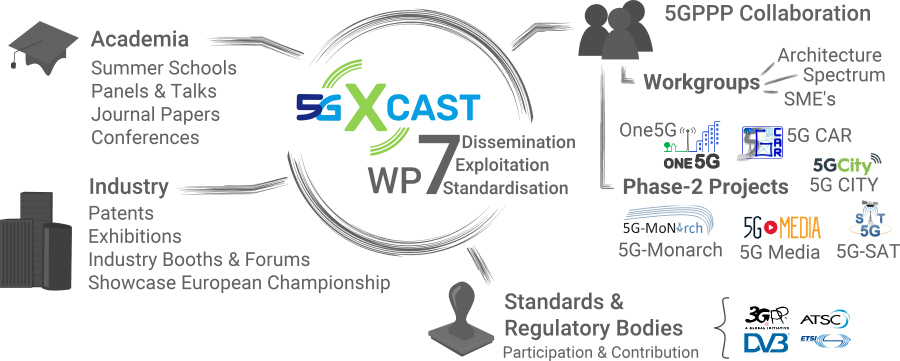
Leader: Samsung (SEUK)
Description
This work package interfaces with the external world in order to promote the results of 5G-Xcast and disseminate them to all interested parties. In order to maximize the impact of the project, the project communications will particularly target M&E stakeholders, the academic, scientific and industrial communities and Standard Developing Organisations. All project partners will contribute to this WP, using various communication channels. Samsung will be in charge of this WP, and will lead the Task 7.2 on standardisation, since it belongs to every Standard Developing Organisation relevant for the project. Task 7.1 will be led by the EBU that as a professional broadcasters’ association facilitates collaboration between its members and with wider industry, standards developing organisations, regulators, and academia, and has considerable expertise in information dissemination.
Objectives
- Promote the project, its objectives, results and the concepts developed.
- Influence standardisation bodies to adopt the concepts developed in 5G-Xcast.
- Coordinate with other 5G European projects for maximum synergy.
- Build awareness on the use of broadcast with its different applications and how 5G-Xcast helps in this regards.
- Maximize the exploitation of the project results by consortium members.
- Maximize the innovation impact of the project.
